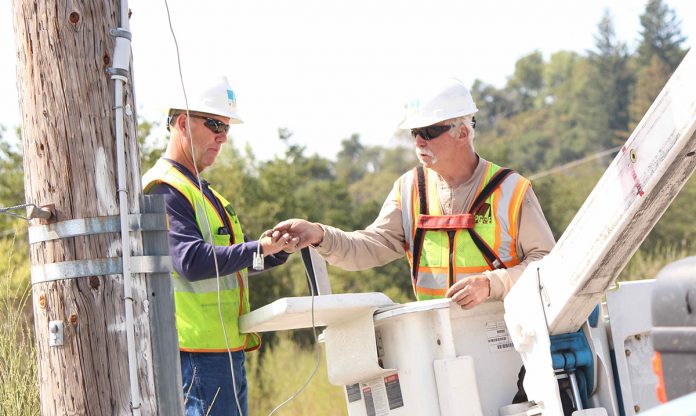A California energy regulator has become so vexed with troubled power provider PG&E following months of planned and unplanned outages it’s started to crackdown.
In a Nov. 1 letter to Santa Cruz County Board of Supervisors Chair Bruce McPherson, California Public Utilities Commission (CPUC) President Marybel Batjer says she’s requiring the company to supply more information about how it will fix problems caused by Fast Trip settings meant to prevent wildfires.
“I share your concerns and frustration about the significant impact that these outages are having on customers,” she said, adding she’s not happy about the poor job PG&E has been doing communicating with customers, either. “Fast Trip outages are more than a matter of inconvenience, they are a life and safety issue.”
PG&E says it likely caused the Dixie Fire, this year, when a tree came into contact with some of its equipment, and the utility pleaded guilty to 84 counts of involuntary manslaughter and one felony fire-starting count in connection to the 2018 Camp Fire.
Last week, the company announced it had reached a $125 million settlement with CPUC for the 2019 Kincade Fire that scorched 77,758 acres.
But in a Sept. 29 letter to the CPUC, McPherson, whose district includes areas of the Santa Cruz Mountains where hundreds of homes were destroyed in last year’s CZU Lightning Complex fires, says the county believes PG&E’s isn’t responding to wildfire risk properly.
“We understand that the Fast Trip sensors are a response to the justified pressure PG&E is receiving for their equipment triggering fires throughout the state, causing the loss of life and structures,” he wrote. “While we support efforts to improve safety, it is hard to believe this Fast Trip approach (and the extreme sensitivity that triggers shutoffs) is anything other than an overcorrection. We would instead encourage PG&E to prioritize hardening the lines in these areas including undergrounding.”
After the sparking of the Dixie Fire, PG&E announced it was going to bury several power lines, something it previously said was too expensive.
According to a recent Wall Street Journal article, this took CPUC by surprise, since no one in the agency had a conversation with anyone at the utility about the idea.
It would cost PG&E just as much to underground its power lines as the entire company is worth, according to the article.
PG&E has, however, been in talks with the regulator so it can charge customers more for electricity.
Since PG&E turned up the sensitivity on its lines in late July, there’ve been 69 outages attributed to the action across Santa Cruz County, which includes Los Gatos customers in the Santa Cruz Mountains (for circuits named “Camp Evers-2105,” “Camp Evers-2106,” “Big Basin-1102,” “Ben Lomond-0401,” “Rob Roy-2104,” “Green Valley-2101” and “Paul Sweet-2106”).
According to PG&E, the circuit that delivers electricity to Los Gatos customers at the Summit, “Camp Evers-2105,” accounted for 19 of these. The other circuit that serves Los Gatos, referred to as “Los Gatos-1106,” has experienced nine outages in that same time period.
So, there were 78 outages in Santa Cruz County and Los Gatos alone thanks to the new setting, which is officially called the Enhanced Powerline Safety Settings program.
But there haven’t been any of these outages since Oct. 22, since PG&E put its equipment back to normal settings just before the October storm. Afterward, company officials affirmed their decision to nix the program, for now, based on low fire danger.
The outages are only adding to the “trauma” Santa Cruz Mountains residents have faced since last year’s fires, McPherson said in his letter to CPUC, and are in addition to Public Safety Power Shutoffs, where PG&E blacks out a section of the grid it worries might not be able to survive a weather event without sparking a blaze.
“To make matters worse, PG&E’s leadership has failed to adequately communicate with residents about what is happening,” he said. “Only after more than six weeks of our repeated requests to host a community meeting with residents did the utility finally agree to host meetings on the afternoon and evening of Sept. 23.”
McPherson asked the CPUC to conduct an investigation of PG&E’s Fast Trip procedures, its “lack of adequate communication” and how the company plans to prevent “extreme” blackouts.
Batjer replied to say she’d sent a letter to PG&E on Oct. 25 to order the utility to “take immediate action to reduce and mitigate customer impacts and ensure that all communities who may be impacted by Fast Trip are better informed and supported.”
The company will provide additional details about the heightened-sensitivity grid in a 2022 Wildfire Mitigation Plan Update, she said.
“In addition, I am requiring PG&E to provide monthly reports to the Director of our Safety Enforcement Division,” she said. “The CPUC will also continue to gather and analyze information regarding PG&E’s implementation of, and communication on, Fast Trip and will take any enforcement actions as appropriate.”
In an Oct. 28 webinar with Santa Cruz County residents, Mark Quinlan, PG&E’s vice president of wildfire mitigation operations, said recent rains brought a much-needed reprieve from the threat of forest fires.
“We really, really needed it,” he said. “But if you were a customer who experienced a power outage during that event, thank you for your patience while our dedicated women and men out there worked around the clock to restore all our customers.”
He again touted a nearly 50% drop in the number of fires it caused since June, which he said proves the Fast Trip approach paid off.
“It came at a cost, and that cost was unacceptable reliability performance,” he said. “We owned that, and we pledged to get better. And we have gotten better.”
Quinlan admitted the company was getting power restoration time estimates wrong more than a quarter of the time, but he said it’s now giving accurate predictions 92% of the time. Plus, he added, outages are getting fixed 33% more quickly.
However, half of customers who message PG&E still aren’t getting a response after two days, according to company data.
Mayra Tostado, a PG&E spokesperson, says PG&E is taking feedback from the utility regulator seriously.
“We agree with the CPUC—and we have shared with our customers on public webinars—that our initial customer communications fell short, and reliability on some circuits has been unacceptably poor,” she said, adding PG&E is working to tweak its Fast Trip program for the future. “We have also taken proactive steps to improve reliability, while also maintaining the wildfire mitigation benefits the program offers.”










